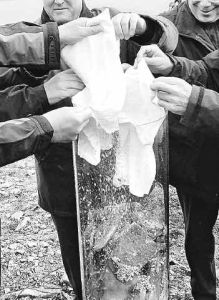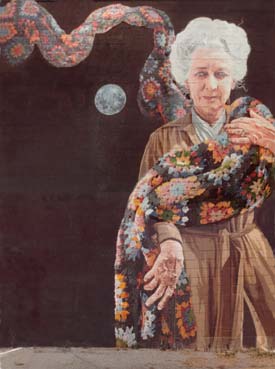

It only takes a film clip to bring it all back — those eyes, that voice, the inevitable look of amused contempt cutting through a sorcerer's haze of cigarette smoke.
During her life, Bette Davis had few peers, and almost 20 years after her death, no actress has even attempted to follow in her footsteps. Probably because the walk alone is beyond the ken of most modern starlets. Two parts what-are-you-looking-at and one part scoot-forward-you'll-get-a-better-view, that elbow-levitating, hip-swinging sashay adored by drag queens for decades distilled the fascinating contradiction of the woman.
Not that there is any one Bette Davis image. Other stars of her era may be more easily summoned to mind — Katharine Hepburn, say, or even Joan Crawford. The Davis oeuvre is more varied than most of the other strong-minded gals of her time — she did Southern belle, she did British monarch, she did New York socialite and aging starlet. The accents may have been a bit perilous, but the stubborn New England fearlessness never was.
Here was someone who would pause mid-stride to light her cigarette off a burning orphanage and, still, you had to love her.
Two recent attempts have been made to explain why. Charlotte Chandler's recent biography, "The Girl Who Walked Home Alone," which was excerpted in a recent Vanity Fair, relies much on several years' worth of interviews with the star. It's a bit like a historic tour of Davis' life with Davis, in all her deadpan staccato splendor, as tour guide. "It was said in my family," the book opens, "that one of my ancestors was a witch. Well, I certainly hope so. It would explain everything." (Davis was one of those people who spoke habitually, and effectively, in italics.)
"Stardust: The Bette Davis Story," which premiered recently on Turner Classic Movies, took a longer view. The documentary obviously originates from a place of homage. Davis, the filmmakers believe, was not only a brilliant actress but also a feminist trailblazer.
Feminist may be a bit of a reach — one TV interview has Davis firmly announcing that it is the role of the "girl" to subsume her life to that of the man, otherwise the marriage won't work. With four failed marriages, she certainly would have known, but it didn't seem to occur to her to question these supposed requirements of marriage.
Beyond that, it is remarkably clear-eyed about its subject, who was a very complicated person, with as many obvious failings as talents. Unlike the recent TV biography of Eugene O'Neill, for instance, in which everything from the playwright's alcoholism to his abandonment of his own children was explained neatly away by his having been "haunted" by an imperfect early family life, "Stardust," like its dyed-in-the-wool Yankee subject, is much more matter-of-fact.
Davis too came from a broken home; her father, never too pleasant to begin with, abandoned his wife and two young daughters to live with his mistress. Bette's mother, Ruthie, quickly poured her considerable energy into her daughter's nascent dramatic career. When a very young Bette came down with measles after landing a plum role — Hedvig in "The Wild Duck" (the part that wakened in Bette the desire to be an actress) — Ruthie promised the director she'd have her daughter up on her feet in 10 days, and she did.
Their relationship would remain intense and symbiotic until Ruthie's death, but while Jones does lay some of Davis' subsequent trouble with men at the feet of her childhood, he is not a Davis apologist. That she was driven, ambitious, probably alcoholic, sometimes violent, always outspoken and ruthlessly certain of her own significance is not, mercifully, fodder for biopic psychoanalysis.
Instead we are shown the extraordinary career that sprung from such a personality — the woman made more than 90 films, many of them classics — as well as the life required to make that career possible. Because, as she said herself many, many times, the work was what really mattered to her.
Which is a good thing because Davis did not have a particularly happy life. Along with the four marriages, she had three children, two of them adopted. One daughter was mildly retarded and institutionalized; the other, B.D., was Davis' constant companion for years, until she wrote a tell-all book that severed their contact. Only her son, Michael Merrill, was interviewed for "Stardust," and though he speaks of his mother with a vague fondness, he is still clearly a bit shellshocked by the experience of being Bette Davis' son.
Part of this is due to the nature of the time. Davis was a movie star when being a movie star was a full-time occupation. She often made as many as three films a year; in the banner year of 1939, she made four. Her personal struggles with Jack Warner, to whom she was under contract for 18 years, were legendary — "She never had an unkind word for Jack," Frank Sinatra said at a banquet honoring Davis. "And the time she stabbed him, it was an accident. She was in his office and she reached for the revolver, the knife slipped out."
Even during the years when she was in hit after hit —she was nominated for 10 Oscars (five in consecutive years) and won two — the industry's devotion, then as now, lasted only a few minutes after the latest box office tally. When she hit her 40s, she learned, as so many actresses have, that age does matter. (It also doesn't help when you've earned a reputation for being almost impossible on the set.) Even after the sweeping success of "All About Eve," in which she played a fading star at the ripe old age of 42, leading film roles were scarce. The late '50s and early '60s were full of television work as Davis struggled to support herself, her children, her sister and her mother.
Beyond a collection of some of the best moments in American film and a mildly intimate look at a woman so well known she was almost her own caricature, what emerges from "Stardust" is the vacuum that Davis and some of her contemporaries left behind. Where is an actress alive today who could utter lines like "I'd kiss ya, but I just washed my hair" or "But you are, you are in that wheelchair, Blanche" or even the classic "What a dump." And where are the writers to write them?
Davis' list of successful films is low on romantic comedies, high on character dramas, and within them she created a series of women who may have wanted to be loved (who doesn't?) but who were also perfectly capable of letting their dream man go with a quip and a shrug if it looked as if he was going to get in the way of what she really wanted. The plot may have required Margo Channing to deliver a nice little soliloquy on the importance of being there for your man, but somehow the audience knew that Eve or no Eve, Margo wasn't going to change one whit.
Imagine an actress today building a successful career with a persona like that. Imagine a series of female-driven films in which the women were allowed to be smart and mouthy and not play second banana, or calculating and vulnerable but not punished for either? A film in which a happy ending was marked by a rueful smile and the admission that the star-crossed couple would just have to remain star-crossed?
Davis was perhaps one of the last of her kind — a Movie Star Who Wanted to Be a Movie Star, who made no apology for grabbing the roles she wanted, who worked pretty much nonstop all her life even when it meant doing "Gunsmoke" and playing creepy nannies, who didn't pretend that she was just like her fans, that she also wanted a "normal" life.
And so she remained, to the end of her life and mostly by the force of her own will, a Big Star, with the cigarette going and the false eyelashes fluttering while she uttered scathing one-liners in that perpetually heartbreaking, heartbroken voice.
Bette Davis, undiluted.
 Los Angeles, June 30, 1919: Just before national prohibition went into effect, banning the sale of alcoholic beverages except for export, the patrons of the city's bars lived it up together one last time, The Los Angeles Times reported under the headline "Jolly End Is Demon's Farewell to Booze".
Los Angeles, June 30, 1919: Just before national prohibition went into effect, banning the sale of alcoholic beverages except for export, the patrons of the city's bars lived it up together one last time, The Los Angeles Times reported under the headline "Jolly End Is Demon's Farewell to Booze". 









































